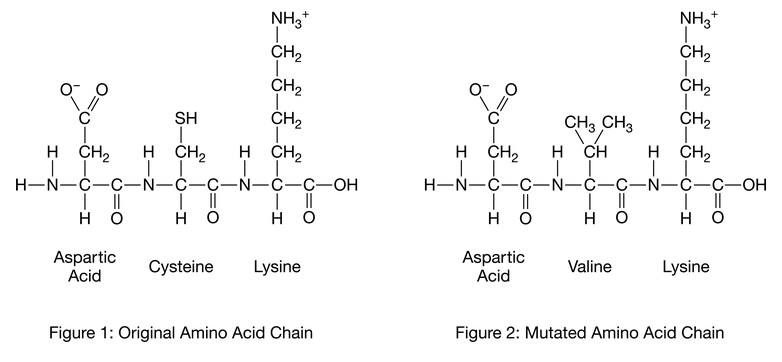Question

Figure 1 represents a segment of DNA. Radiation can damage the nucleotides in a DNA molecule. To repair some types of damage, a single nucleotide can be removed from a DNA molecule and replaced with an undamaged nucleotide. Which of the four labeled bonds in Figure 1 could be broken to remove and replace the cytosine nucleotide without affecting the biological information coded in the DNA molecule?
A. Bond X only
B. Bond W only
C. Bonds Y and Z at the same time
D. Bonds W and Z at the same time
▶️Answer/Explanation
Ans: C
By breaking bonds Y and Z at the same time, the cytosine nucleotide could be removed from the DNA molecule and replaced with an undamaged cytosine without changing the biological information stored in the DNA.
Question
Different polysaccharides are used by plants for energy storage and structural support. The molecular structures for two common polysaccharides are shown in Figure 1. Starch is used by plants for energy storage, and cellulose provides structural support for cell walls. The monomer used to construct both molecules is glucose.

A study determined the effect of two different digestive enzymes, A and B, on these two polysaccharides. Table 1 presents the data from the study.
Mammals do not produce digestive enzyme B. However, sheep and cattle are two types of mammals that contain microorganisms in their digestive tract that produce enzyme B.
Which of the following would most likely occur if cattle lost the ability to maintain a colony of microorganisms in their digestive tract?
A. Cattle would no longer be able to synthesize cellulose.
B. Cattle would have to convert cellulose to starch before digesting it.
C. Cattle would have to start producing enzyme B without the help of the bacteria.
D. Cattle would no longer be able to use cellulose as a primary source of glucose.
▶️Answer/Explanation
Ans: D
Without the enzyme B produced by microorganisms in their digestive tract, cellulose would pass through the digestive tract without being digested.
Question
Figure 1 shows three amino acids that are part of a polypeptide chain. Figure 2 shows the same section of the chain after a mutation has occurred.

How might this change affect the structure and function of the protein?
A. The R-group of the new amino acid, valine, has different chemical properties than the R-group of cysteine. This will cause the protein to misfold and not function properly in the cell.
B. The new amino acid, valine, has replaced cysteine in the new protein. Since the number of amino acids has remained the same, there will be no change in the three-dimensional folding, or function, of the protein.
C. Since this is a linear section, it does not influence protein folding. Thus, there will be no change in protein structure or function.
D. Since the new amino acid is bounded on one side by an amino acid with a negatively charged R-group and by an amino acid on the other side with a positively charged R-group, the charges will balance and the protein will fold as usual.
▶️Answer/Explanation
Ans: A
Three-dimensional folding of a protein is due to interactions among the R groups of the amino acids. Cysteine has a sulfhydryl group, which may form a disulfide bridge with another part of the polypeptide chain. Valine has no sulfhydryl group and is nonpolar, which will affect how the polypeptide will fold.
Question
Which of the following best describes the formation of the primary structure of a protein?
(A) A dehydration reaction forms an ionic bond between the carboxyl
group of one amino acid and the amino group of another amino
acid.
(B) A dehydration reaction forms a covalent bond between the
carboxyl group of one amino acid and the amino group of another
amino acid.
(C) A hydrolysis reaction forms an ionic bond between the carboxyl
group of one amino acid and the amino group of another amino
acid.
(D) A hydrolysis reaction forms a covalent bond between the carboxyl
group of one amino acid and the amino group of another amino
acid.
▶️Answer/Explanation
Ans:
(B) The primary structure of a protein is formed by linking amino
acids, and dehydration reactions link amino acids in covalent bonds
between the carboxyl group of one amino acid and the amino group of
another amino acid. Choice (A) is incorrect because dehydration
reactions do not form ionic bonds. Choices (C) and (D) are incorrect
because hydrolysis reactions break, not form, bonds between
monomers.
Question
Which level of protein structure is formed by peptide bonds between amino acids?
(A) primary
(B) secondary
(C) tertiary
(D) quaternary
▶️Answer/Explanation
Ans:
(A) The primary structure of a protein is the sequence of amino acids
held together by peptide bonds. Choice (B) is incorrect because
secondary structure is formed by the hydrogen bonds between amino
acids in a polypeptide chain. Tertiary structure is the globular shape
formed by a polypeptide chain, so choice (C) is incorrect. Choice (D) is
incorrect because quaternary structure is formed when multiple
subunits come together to form the functional protein.
